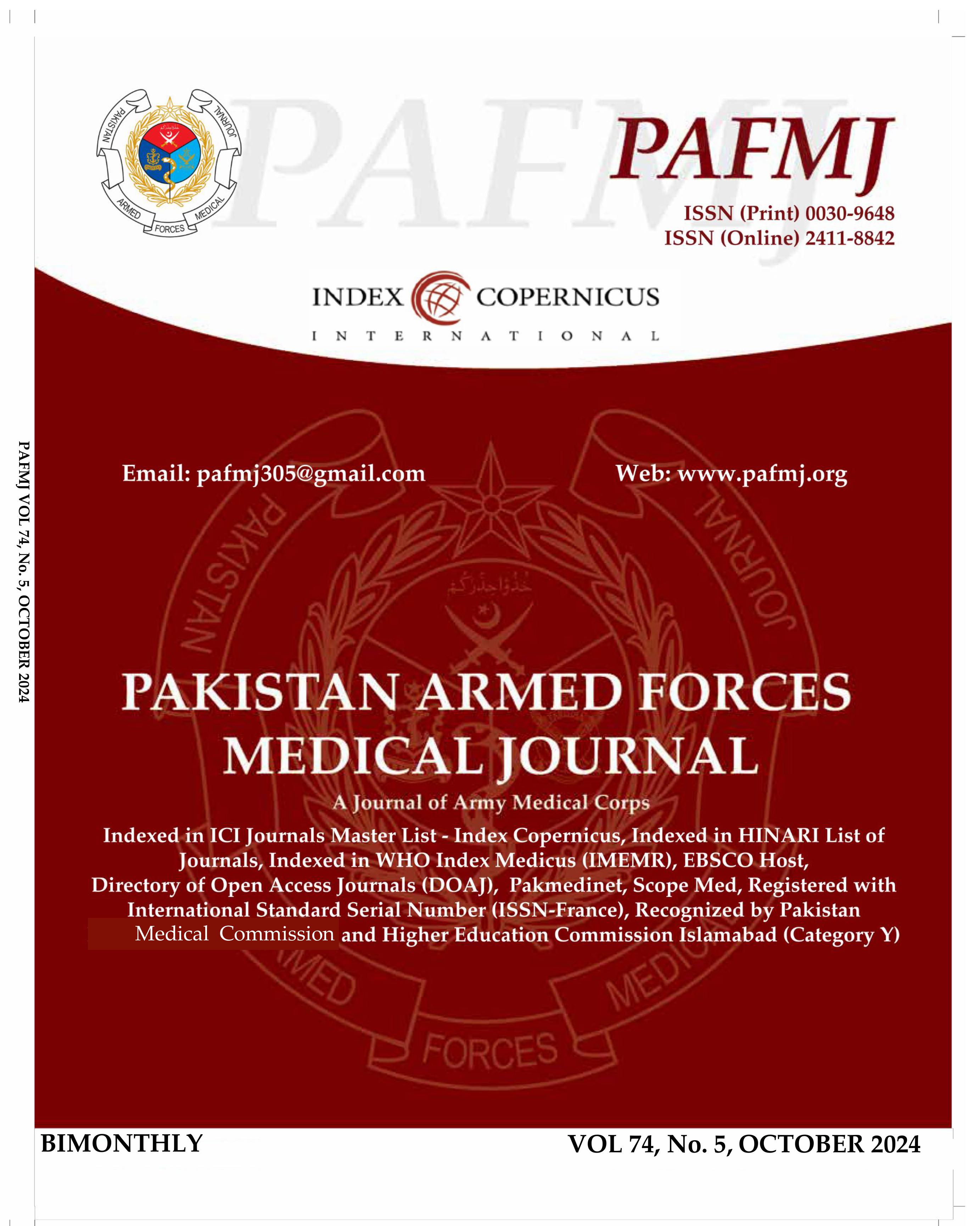Iron Deficiency Anemia Among Women in Skardu, Gilgit-Baltistan
DOI:
https://doi.org/10.51253/pafmj.v74i5.9441Keywords:
Community health, Hemoglobin, Iron deficiency anemia, Reproductive medicine.Abstract
ABSTRACT
Objective: To determine the frequency of iron deficiency anemia among women in Skardu, Gligit-Baltistan.
Study Design: Cross-sectional study.
Place and Duration of Study: Combined Military Hospital, Skardu, Pakistan, from Dec 2021 to May 2022.
Methodology: A total of 202 women were selected through consecutive sampling from General Medical OPD of Combined Military Hospital, Skardu, Pakistan. Hemoglobin globin levels (Hb gram/deciliter), mean corpuscular volume (MCV fL) and red cell distribution width (RDW%) were determined for all enrolled patients.
Results: Mean age of participants in this study was 34.46±10.93 years. Reduced Hb was observed in 62(30.69%) women with a mean hemoglobin level of 9.48±1.59 gl/deciliter and mean corpuscular volume of 79.97±10.7d fL. Among these women, 5(2.47%) were severely anemic (6.56±0.39 gl/deciliter), 28(13.86%) moderately anemic (8.51±0.83 gl/deciliter) while 29(14.35%) were mildly anemic (10.92±0.48 gl/deciliter). Women of younger age group, between18-35 years, were found to suffer more from iron deficiency anemia (39.14%) with mean hemoglobin levels of 11.31±1.80 and mean corpuscular volume of 79.34±10.86 fL.
Conclusion: Iron Deficiency Anemia is present in female population of Gilgit-Baltistan in general and woman of childbearing age in particular. Emergency measures for awareness and fortification of basic food items with iron should be undertaken at large scale.
Downloads
References
Qadir MA, Rashid N, Mengal MA, Hasni MS, Kakar SUD, Khan GM, et al. Iron-deficiency anemia in women of reproductive age in urban areas of Quetta District, Pakistan. Biomed Res Int 2022; 2022: 6677249.
https://doi.org/10.1155/2022/6677249
Anjum A, Ali TS, Pradhan NA, Khan M, Karmaliani R. Perceptions of stakeholders about the role of health system in suicide prevention in Ghizer, Gilgit-Baltistan, Pakistan. BMC Public Health 2020; 20(1): 991.
https://doi.org/10.1186/s12889-020-09016-4
McLean E, Cogswell M, Egli I, Wojdyla D, Benoist B. Worldwide prevalence of anemia, WHO mineral nutrition information system, 1993-2005. Public Health Nutr 2009; 12: 444-454.
https://doi.org/10.1017/S1368980008002401
Nouri A, Matur A, Pennington Z. Prevalence of anemia and its relationship with neurological status in patients undergoing surgery for degenerative cervical myelopathy and radiculopathy: a retrospective study of 2 spine centers. J Clin Neurosci 2020; 72: 252-257. https://doi.org/10.1016/j.jocn.2020.01.041
Nasir BB, Fentie AM, Adisu MK. Adherence to iron and folic acid supplementation and prevalence of anemia among pregnant women attending antenatal care clinic at Tikur Anbessa Specialized Hospital, Ethiopia. PLoS One 2020; 15(5): e0232625.
https://doi.org/10.1371/journal.pone.0232625
Mehrotra M, Yadav S, Deshpande A, Mehrotra H. A study of the prevalence of anemia and associated sociodemographic factors in pregnant women in Port Blair, Andaman and Nicobar Islands. J Family Med Prim Care 2018; 7(6): 1288-1293.
https://doi.org/10.4103/jfmpc.jfmpc_297_18
Osungbade KO, Oladunjoye AO. Preventive treatments of iron deficiency anaemia in pregnancy: a review of their effectiveness and implications for health system strengthening. J Pregnancy 2012; 2012: 454601.
https://doi.org/10.1155/2012/454601
Ministry of National Services Regulation and Coordination (MoNHSR&C)GoP. National Nutrition Survey; 2018.
Hambidge KM, Bann CM, McClure EM, Westcott JE, Garcés A, Figueroa L, et al. Maternal characteristics affect fetal growth response in the women first preconception nutrition trial. Nutrients 2019; 11(10): 2534.
https://doi.org/10.3390/nu11102534
Muckenthaler MU, Mairbäurl H, Gassmann M. Iron metabolism in high-altitude residents. J Appl Physiol. 2020; 129(4): 920-925.
https://doi.org/10.1152/japplphysiol.00388.2020
Qadir MA, Rashid N, Mengal MA, Hasni MS, Kakar SUD, Khan GM, et al. Iron-deficiency anemia in women of reproductive age in urban areas of Quetta District, Pakistan. Biomed Res Int 2022; 2022: 6677249. https://doi.org/10.1155/2022/6677249
Bharati P, Som S, Chakrabarty S, Bharati S, Pal M. Prevalence of anemia and its determinants among nonpregnant and pregnant women in India. Asia Pac J Public Health 2008; 20(4): 347-359.
https://doi.org/10.1177/1010539508316931
Retnakumar C, Chacko M, Ramakrishnan D, George LS, Krishnapillai V. Prevalence of anemia and its association with dietary pattern among elderly population of urban slums in Kochi. J Family Med Prim Care 2020; 9(3): 1533-1537.
https://doi.org/10.4103/jfmpc.jfmpc_1056_19
Arabyat R, Arabyat G, Al Taani G. Prevalence and risk factors of anaemia among ever-married women in Jordan. East Mediterr Health J 2019; 25(8): 543-552.
https://doi.org/10.26719/emhj.19.009
Ganapathi KC, Kumar KR. A cross-sectional study of anemia among women of reproductive age group (15-49 years) in a rural population of Tamil Nadu. Int J Med Sci Public Health 2017; 6(3): 524-530.
https://doi.org/10.5455/ijmsph.2017.0207727022017
Chandyo RK, Strand TA, Ulvik RJ. Prevalence of iron deficiency and anemia among healthy women of reproductive age in Bhaktapur, Nepal. Eur J Clin Nutr 2007; 61(2): 262-269.
https://doi.org/10.1038/sj.ejcn.1602506
Benoist BD, McLean E, Egli I, Cogswell M. Worldwide prevalence of anaemia 1993-2005, WHO Global Database on Anaemia, Geneva, Switzerland; 2008.
Zhang X, He Y, Xie X, Ji M, Ma X, Yu Z. Distribution of hemoglobin and prevalence of anemia in 10 ethnic minorities in China: a population-based, cross-sectional study. Medicine 2017; 96(5): e9286.
https://doi.org/10.1097/MD.0000000000009286
Lilare RR, Sahoo DP. Prevalence of anaemia and its epidemiological correlates among women of reproductive age group in an urban slum of Mumbai. Int J Community Med Public Health 2017; 4(8): 2841-2846.
https://doi.org/10.18203/2394-6040.ijcmph20173350
Verma R, Kharb M, Deswal S, Arora V, Kamboj R. Prevalence of anaemia among women of reproductive age group in a rural block of Northern India. Indian J Med Community Health 2014; 26(2): 359-364.
Abuaisha H, Itani H, El Masri R, Antoun J. Prevalence of iron deficiency without anemia in the general population presenting to primary care clinics: a cross-sectional study. Postgrad Med 2020; 132(3): 282-287.
https://doi.org/10.1080/00325481.2020.1718094
Ndegwa SK. Anemia and its associated factors among pregnant women attending antenatal clinic at Mbagathi County Hospital, Nairobi County, Kenya. Afr J Health Sci 2019; 32(1): 59-73.
Asres Y, Yemane T, Gedefaw L. Determinant factors of anemia among nonpregnant women of childbearing age in southwest Ethiopia: a community-based study. Int Sch Res Notices. 2014; 2014: 391580. https://doi.org/10.1155/2014/391580
Downloads
Published
Issue
Section
License
Copyright (c) 2024 Qasim Zia, Irfan Khattak, Malik Nadeem Azam, Ahmar Rasheed, Asad Ali, Anam Manzoor

This work is licensed under a Creative Commons Attribution-NonCommercial 4.0 International License.















